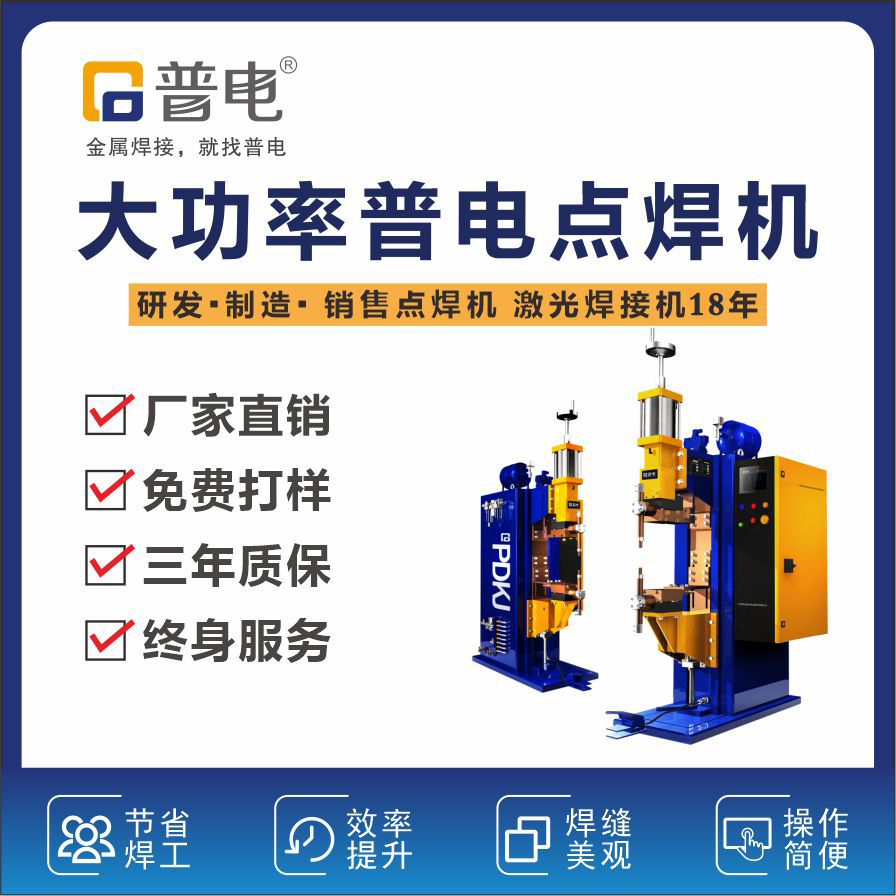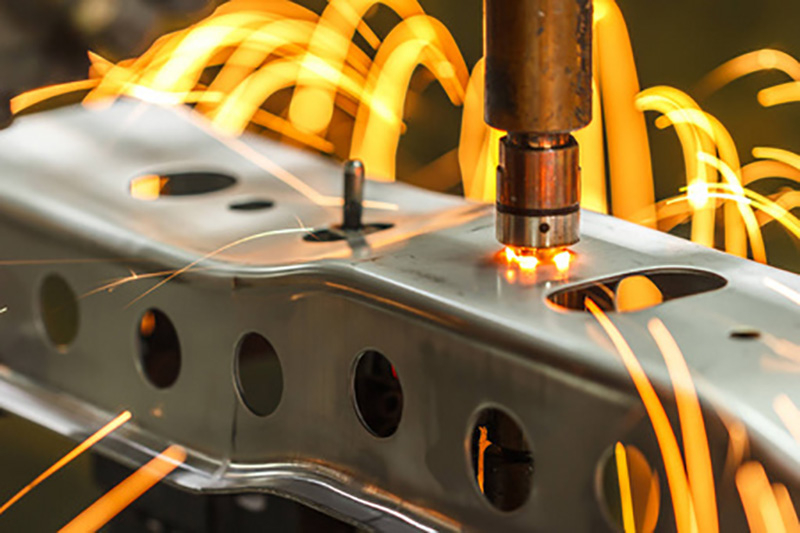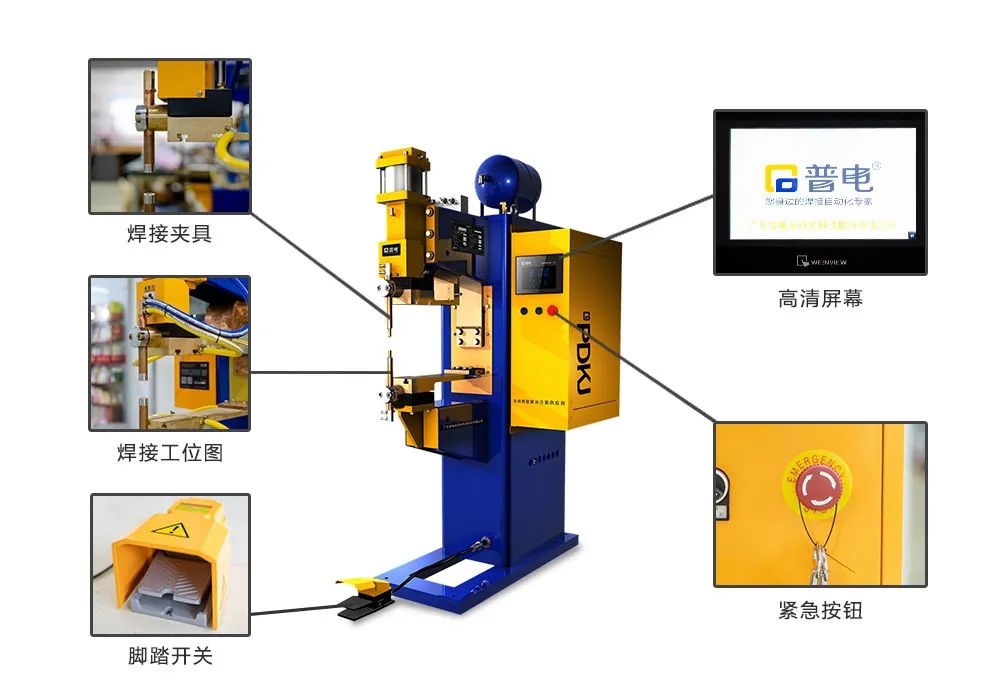1、 Spot welding process
Spot welding, as the name suggests, is a process of locally heating and melting two metal plates, and then applying pressure to recrystallize the melted part, ultimately achieving a firm connection between the metal plates. In industrial production, spot welding is mainly used for the splicing, reinforcement, and connection of metal sheets. Spot welding is mainly applied in the following areas:
1. Automotive manufacturing: can be used for welding body components, chassis, engine hood, door panels, and frame structures. In particular, spot welding technology plays an important role in the overlap and fixation of sheet metal stamping parts on the vehicle body.
2. Lithium ion battery manufacturing: used for welding the positive and negative electrodes of batteries, ensuring their safety performance and service life.
3. Aerospace: widely used for welding key components such as aircraft fuselage, wings, and engines.
4. Household appliance manufacturing: mainly used for welding and fixing thin plate structures. Products such as air conditioners, refrigerators, washing machines, etc.
5. Electronic and electrical components industry: Spot welding technology is used in the welding of silver contacts on various switches and electronic components.
6. Other industrial manufacturing fields: In addition to the above-mentioned fields, spot welding technology is also widely used in the welding of metal structures in industries such as pipelines, construction, ships, railways, and petrochemicals.
2、 Characteristics
During spot welding, the welded part forms an overlapping joint and is pressed between two electrodes. Its main characteristics are as follows:
1. Fast welding speed: Due to the fact that spot welding only heats up the local area of the connection, and the heating time is short, the welding speed is fast and the production efficiency is high.
2. Stable and reliable quality: During spot welding, the heating time for the connection area is very short, the welding speed is fast, so the heat affected zone is small, the deformation of the welded part is small, and cracks are not easy to occur. Meanwhile, due to the fact that spot welding only consumes electrical energy and does not require filling materials, fluxes, gases, etc., the welding quality is stable and reliable.
3. High degree of mechanization and automation: The spot welding machine adopts an automated control system, which can achieve continuous and automated production, and improve production efficiency. At the same time, spot welding machines use electrode pressure for welding, which can avoid errors caused by manual operations and ensure the stability and consistency of welding quality.
4. Low labor intensity: Spot welding machines are easy to operate, with high levels of mechanization and automation, resulting in lower labor intensity for workers.
5. High equipment cost: Due to the use of high current and pressure for welding in spot welding machines, the equipment has a higher power and cost. Meanwhile, due to the use of electrodes for welding in spot welding machines, the cost of consumables for electrodes is also high.
6. It is difficult to perform non-destructive testing on welds: due to the short heating time and fast welding speed of spot welding, non-destructive testing of welds is more difficult.
3、 Operation process
Before welding, the surface of the workpiece should be cleaned thoroughly. The commonly used cleaning method is acid washing, which involves first pickling in sulfuric acid with a heated concentration of 10%, and then rinsing in hot water.
The specific welding process is as follows:
(1) Put the workpiece joint between the upper and lower electrodes of the spot welding machine and clamp it;
(2) Electrify, causing the contact surface of two workpieces to be heated, locally melting, and forming a molten nucleus;
(3) Maintain pressure after power outage to cool and solidify the molten core under pressure, forming solder joints;
(4) Remove pressure and remove the workpiece.
4、 Influencing factors
The main influencing factors of welding quality include welding current and energization time, electrode pressure, and shunt.
1. Welding current and energization time: Spot welding can be divided into two types: hard specification and soft specification based on the size of welding current and the length of energization time. A standard that can withstand high current in a short period of time is called a hard standard. It has advantages such as high productivity, long electrode life, and small deformation of welded parts, making it suitable for welding metals with good thermal conductivity. A specification that uses a smaller current for a longer period of time is called a soft specification, which has lower productivity and is suitable for welding metals with a tendency to harden.
2. During electrode pressure spot welding, the pressure applied to the workpiece through the electrode is called electrode pressure. Appropriate electrode pressure can ensure good contact between metals in the welding area, promote heat transfer, and facilitate metal fusion. When the pressure is high, it can eliminate the possible shrinkage and porosity that may occur during the solidification of the weld nuggets. However, the decrease in resistance and current density during welding leads to insufficient heating of the weld, a decrease in the diameter of the weld nuggets, and a decrease in the strength of the weld.
The magnitude of electrode pressure can be selected based on the following factors:
(1) Material of the welded part. The higher the high-temperature strength of the material, the greater the required electrode pressure. Therefore, when welding stainless steel and heat-resistant steel, an electrode pressure greater than that of welding low-carbon steel should be selected.
(2) Welding parameters. The harder the welding specification, the greater the electrode pressure.
3. During spot welding, the current flowing outside the main welding circuit is called shunt. Shunting reduces the current flowing through the welding area, resulting in insufficient heating and a significant decrease in the strength of the solder joint, which affects the welding quality.
The factors that affect the degree of diversion mainly include the following aspects:
(1) the thickness of the weld and the spacing between the weld points. As the distance between solder joints increases, the shunt resistance increases and the degree of shunt decreases. When using a conventional point spacing of 30-50mm, the shunt current accounts for 25% to 40% of the total current, and the degree of shunt also decreases as the thickness of the weld decreases.
(2) Surface condition of welded parts. When there are oxides or dirt on the surface of the welded part, the contact resistance between the two welded parts increases, and the current passing through the welding area decreases, that is, the degree of diversion increases. The workpiece can be pickled, sandblasted, or polished.
5、 Safety precautions
(1) The foot switch of the welding machine should have a sturdy protective cover to prevent accidental activation.
(2) The homework site should be equipped with baffles to prevent work sparks from splashing.
(3) When welding, welders should wear flat protective goggles, gloves, work clothes, etc.
(4) The place where the welding machine is placed should be kept dry, and the ground should be covered with anti-skid boards.
(5) After the welding work is completed, the power should be cut off, and the cooling water switch should be extended for 10 seconds before turning off. When the temperature is low, the accumulated water in the water circuit should also be drained to prevent freezing.
Scan the QR code and follow General Electric Technology.
National service hotline: 400-088-2398
Contact phone number: 13631767737(same WeChat account)
Spot Welder for
Complete understanding of spot welding technology, at a glance, code first and t,Spot Welding Machine for
Complete understanding of spot welding technology, at a glance, code first and t, Laser Welder for
Complete understanding of spot welding technology, at a glance, code first and t, Laser Welding Machine for
Complete understanding of spot welding technology, at a glance, code first and t,Spot Welder manufacturer in China,
Complete understanding of spot welding technology, at a glance, code first and t Laser Welder manufacturer from China
go to see
Welding Machine for Complete understanding of spot technology, at a glance, code first and t



